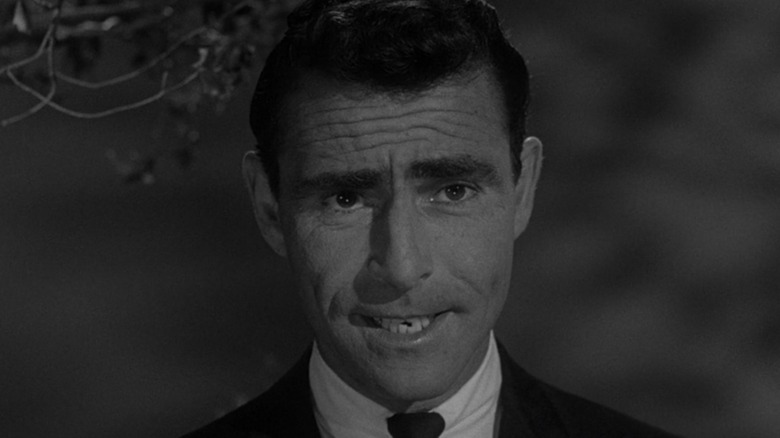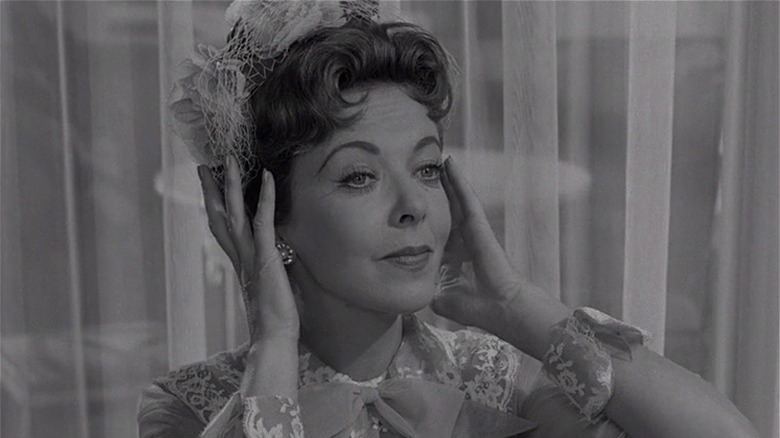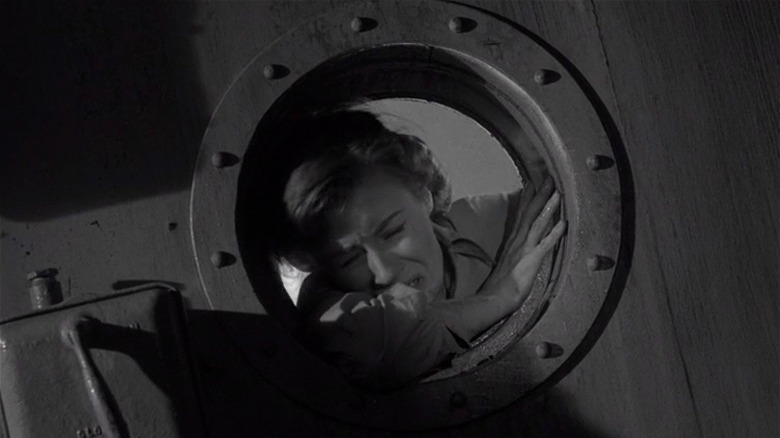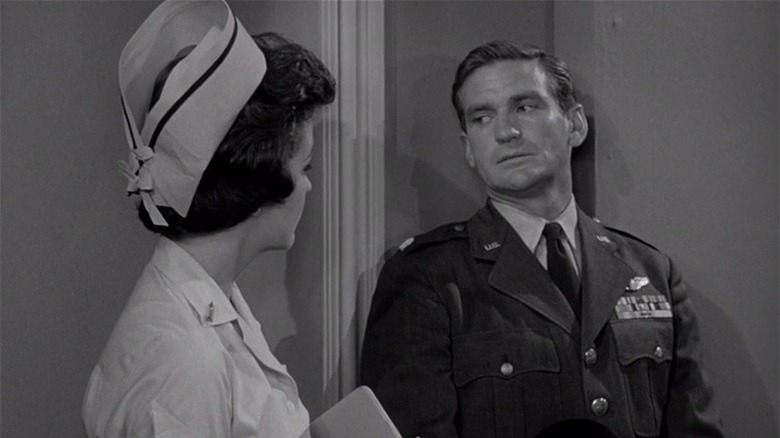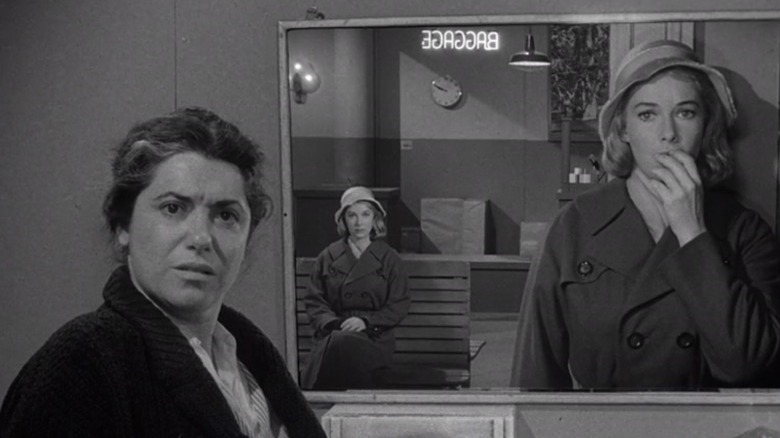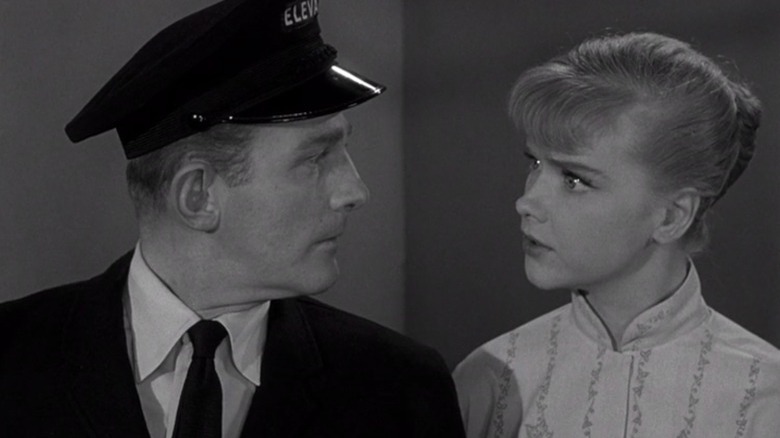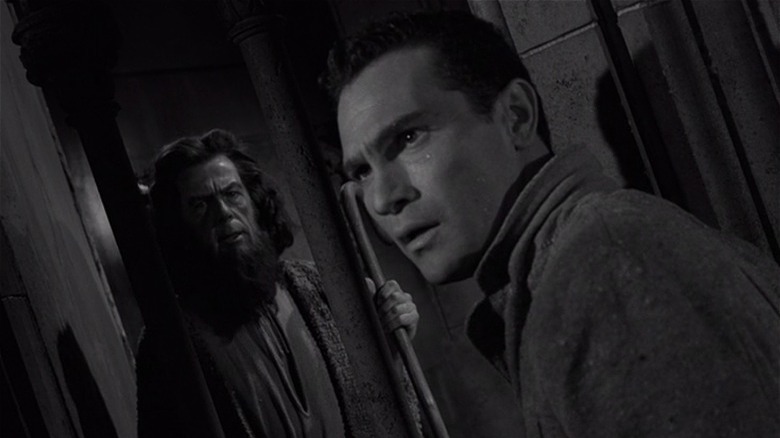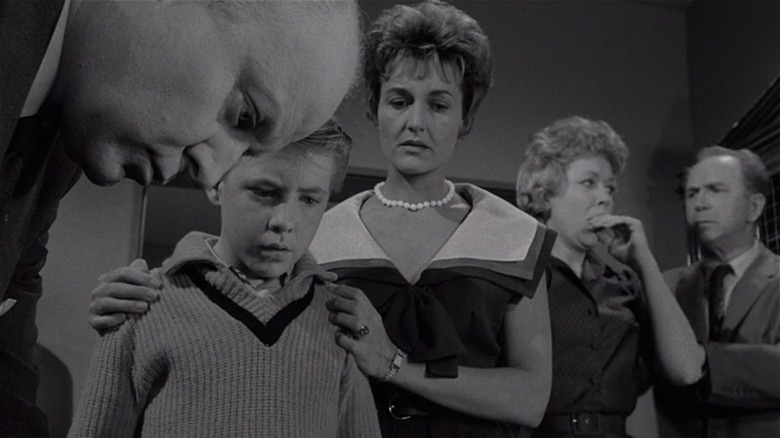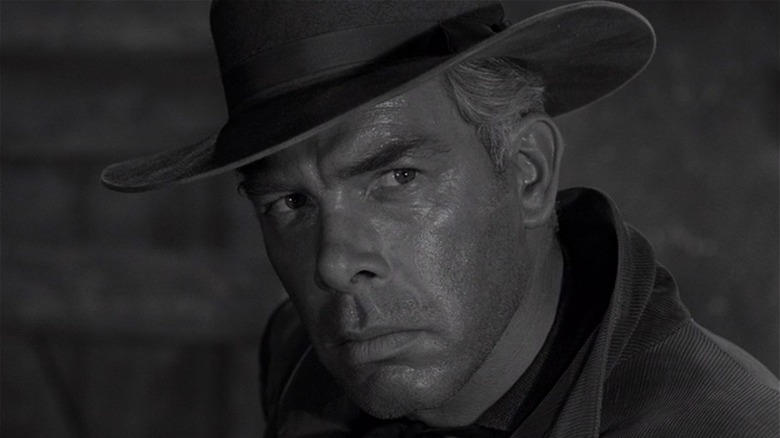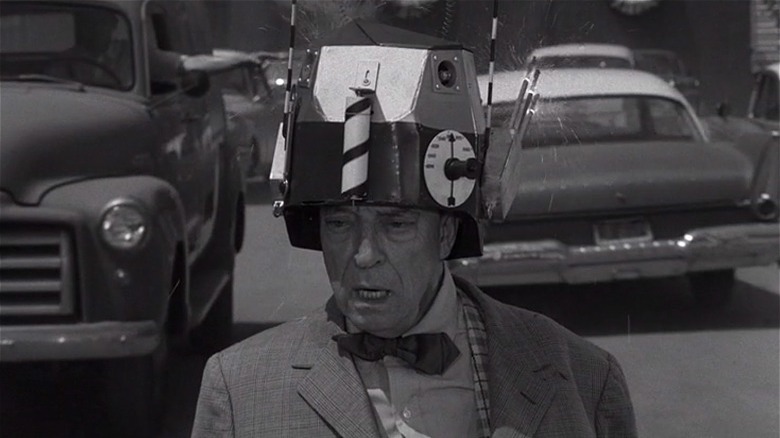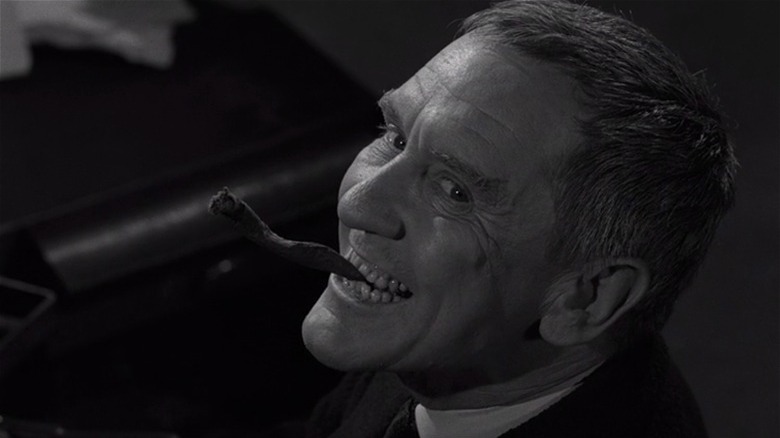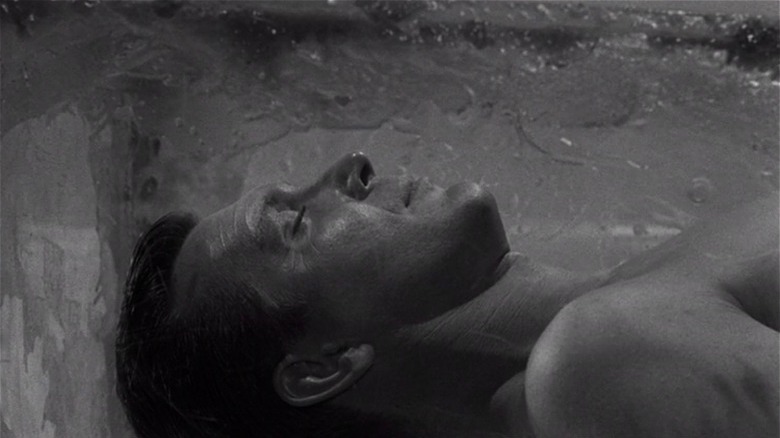12 Underrated Episodes Of The Twilight Zone
A lot of episodes of "The Twilight Zone" have become stone-cold classics in the 60+ years since the show was on the air. There are some episodes that are pop-cultural touchstones, twist-ending stories that everyone remembers: the monster on the wing of the plane, the one where she's beautiful and everyone else is ugly, the one where it's a cookbook, etc. The most famous episodes have been made and re-made several times over the course of the show's life, reappearing in films, revival series, and even as radio dramas (now available in podcast form thanks to iHeartRadio!).
However, there were 153 episodes in the original run, and they can't all be re-run in primetime on SyFy every New Years' Day. Marathons tend to stick to the classics. Still, there are plenty of other episodes well worth checking out. Even when "The Twilight Zone" wasn't at its absolute best, it's still "The Twilight Zone," so it's pretty much always worthwhile. Or, to paraphrase the great Rod Serling: You're traveling through another dimension, a dimension not only of sight and sound but of mind. A journey into a wondrous land whose boundaries are that of imagination. That's the signpost up ahead! Your next stop: a roundup of 12 underrated episodes of ... "The Twilight Zone."
The Sixteen-Millimeter Shrine (Season 1, Episode 4)
Ida Lupino was a pioneering filmmaker, the first woman to direct a film noir with 1949's "Never Fear." She had a number of feature films under her belt, including "The Hitch-Hiker," before transitioning to television work. She continued to act as well, starring in one of the very first episodes of "The Twilight Zone" titled "The Sixteen-Millimeter Shrine."
In this episode (which owes a bit of a debt to "Sunset Blvd."), Lupino plays Barbara Jean Trenton, a film star of the 1930s who is unable to cope with the fact that she is aging out of the starlet roles she once adored. Instead, Barbara spends her days holed up in her Beverly Hills mansion, watching and rewatching her old films on a projector in her study. She prefers to lose herself in the fantasy of her youth rather than address the fact that she is better suited for roles as a mother nowadays, to the consternation of her agent (Martin Balsam, the year before he investigated Norman Bates in "Psycho"). Lupino is tremendous, bringing a wonderful gravitas to the role that carries the character through the surrealist, depressing ending of the episode. Her film work as a director deserves to be better remembered, and so too does her appearance in "The Twilight Zone."
Judgment Night (Season 1, Episode 10)
Carl Lanser (Nehemiah Persoff) is a man on a ship who knows he does not belong. He can't remember much, but the year is 1942 and he's on a British liner trapped in the fog. All Lanser knows is that he was born in Frankfurt, and he is soon gripped by the unshakable feeling that a German U-Boat stalks them through the open ocean, just out of sight in the darkness.
"The Twilight Zone" ran a number of World War II-themed episodes over the years, but "Judgment Night" was the first and remained one of the best. Persoff's performance is haunting, shot through with a wild-eyed horror that feels at times uncomfortable to witness. It's also a rare "Twilight Zone" episode that doesn't have a twist, per se. Instead, the episode parcels out its clues early, the dramatic tension coming from the fact that we realize what is happening long before the main character does. There is only the crushing inevitability of what's coming, and when it arrives it's utterly frightening.
And When The Sky Was Opened (Season 1, Episode 11)
Rod Taylor stars in "And When The Sky Was Opened" as Col. Clegg Forbes, a recently-returned astronaut from an experimental flight that lost contact with ground control for 24 hours. While speaking with a fellow spaceman named Maj. William Gart (Jim Hutton), Forbes realizes that he's the only one who remembers the third man on their mission, Col. Ed Harrington (Charles Aidman). Most of the episode is told in flashback to the previous day when Harrington was still around, and we watch as Forbes loses his grip on his sanity when his friend slips away. Over the course of its run, "The Twilight Zone" managed to nab numerous talented actors at the outset of their fame. George Pal's Rod Taylor-led adaptation of "The Time Machine" would open less than a year after this episode aired, making his career. He's excellent here, his performance a live-wire of anxiety and terror.
"And When The Sky Was Opened" is based on a short story written by Richard Matheson, best known for penning classics like "The Shrinking Man" and "I Am Legend." Matheson wrote several "Twilight Zone" teleplays directly, including the classic episode "Nightmare at 20,000 Feet," but in this case, the show's creator Rod Serling adapted Matheson's work. Like many of the best episodes of "The Twilight Zone," it feels like it could have been torn from the pages of EC Comics, perhaps appearing as an installment of Weird Science.
Mirror Image (Season 1, Episode 21)
In "Mirror Image," Millicent Barnes (Vera Miles) is a woman waiting for a bus that's behind schedule. When she asks the man behind the station ticket booth how much longer he expects it'll be, he's exasperated because he claims she just asked him the same question. She begins to realize that something is amiss: there's another person waiting at the bus stop who looks just like her. According to "The Twilight Zone Encyclopedia," Rod Serling got the idea when he was in an airport. "I noticed a person walking past me, carrying a bag very similar to my own," he recalled. "I looked up and saw the person from the back. The build, the back of the head, etc., were identical to my own, and while I never did see who the unlucky guy was, it provided a springboard to an idea."
The beauty of "Mirror Image" lies in its simplicity. This is a story that takes place primarily in one room, with only a handful of actors. It's a confusing little puzzle, one that easily keeps the viewer intrigued all the way through. The best part of the episode comes at the very end when the camera finally breaks free from the bus station and there's a cathartic, surreal, oddly-beautiful chase sequence featuring a twinkling piano score. It's "The Twilight Zone" at its very best — neatly-plotted, always intriguing, and ultimately transcendent.
The After Hours (Season 1, Episode 34)
"The After Hours" takes a classic "Twilight Zone" plot — one person remembers something that seems to have slipped out of reality, causing everyone else to forget — and knocks it out of the park. In this episode, the person doing the remembering is Marsha (Anne Francis, star of "Forbidden Planet"), a woman who insists that she just purchased something on the ninth floor of a department store ... a floor that, according to everyone else, doesn't exist. It's a classic tale of a customer demanding something a business can't provide, except this department store is located in the Twilight Zone, so she might just be correct after all.
A lot of "Twilight Zone" episodes that attempt horror seem quaint to modern eyes (the gremlin on the wing of the plane, for one), but the climax of "The After Hours" remains genuinely chilling. The score falls away, and as Marsha tries to escape the department store that has closed for the night and locked her in, the mannequins leer and loom large. All we can hear are her gasps of fright ... and perhaps our own. According to Steven Jay Rubin's "The Twilight Zone Encyclopedia," Francis later recalled, "It was a five-day project and we rehearsed for three days like it was theater, and this character I played had to build up to this insane hysteria at the end. So being able to do it straight through was fabulous." It worked, as she's excellent in the part.
The Howling Man (Season 2, Episode 5)
In "The Howling Man," H. M. Wynant plays David Ellington, a WWI vet who has found himself lost in a storm. He reaches a mysterious hermitage and begs for rest, but the Brotherhood who guard the building don't want to provide him sanctuary. There's a man in a cell in the dungeon, howling for release, and though the man (Robin Hughes) says the brothers are stark raving mad, the brothers claim the man is Satan himself. They've had him trapped since the end of the first World War, believing that his imprisonment is responsible for the relative peace enjoyed by humanity in the years afterward.
"The Howling Man" is incredibly atmospheric. In addition to the ever-present sound of wind and rain lashing the windows, the howling man's cries are genuinely upsetting. The episode is shot in both canted angles and frequent closeups, making it a disorienting viewing experience. We in the audience feel just as unsteady as Ellington himself. The leader of the Brotherhood is played by the legendary character actor John Carradine, whose performance is a real treat, and the close-ups of his craggy face give the episode the solemnity it needs. Wynant loved working with Carradine, as "The Twilight Zone Encyclopedia" quotes the actor's memories of the episode's rehearsal process: "The two days of rehearsal was a quick read-through of the script and John Carradine, for the next two days, telling stories. It was the best time of my life."
The Shelter (Season 3, Episode 3)
The original run of "The Twilight Zone" bridged the 1950s and 60s, so it makes sense that a number of episodes grapple with the emotional paranoia of the ongoing Cold War. Some of these episodes are stone-cold classics, like"The Monsters Are Due On Maple Street," and "The Shelter" deserves to be just as well-known. At the start of the episode, a radio broadcast alerts anyone who's listening that unidentified objects have been spotted over American skies, and residents are urged to seek cover and not leave their homes. Fear of an imminent bomb sends a neighborhood dinner party scrambling for the one house on the street that has a fallout shelter, even though the family with the resource doesn't want to let everyone inside because they only have enough supplies for themselves.
Neighbor turns against neighbor, and the sharp divisions between them all are laid bare for everyone to see. It's a desperately-uncomfortable watch, and the moral questions it raises are just as relevant today as they were when the episode first aired. How do we go on living alongside people who are, nakedly, only out for themselves? How do we survive with people who would claw away our meager resources just so they have something for themselves? In the end, Rod Serling narrates, "No moral, no message, no prophetic tract. Just a simple statement of fact: for civilization to survive, the human race has to remain civilized." We'd do well to heed "The Shelter's" warning.
The Grave (Season 3, Episode 7)
Oscar-winner Lee Marvin is another future star who appeared on "The Twilight Zone" before his career really took off, about a year before he showed up in "The Man Who Shot Liberty Valance." In one of the show's best Western episodes titled "The Grave," Marvin plays Conny Miller, a bounty hunter who is warned to stay away from the grave of a man he was hunting. In his dying moments, the man told the local townspeople that if Conny were ever to come near his final resting place, he would reach up out of the grave to grab him. The episode also features James Best, who would much later teach a young man named Quentin Tarantino to act. Best plays Johnny Rob, a guitar-playing, a whiny local who bets Conny that he won't go near the grave.
The twist at the end of the episode is a simple one, but it's the execution that ties the story together. When Conny does approach the cemetery where his old nemesis has been laid to rest, the scene becomes mostly silent except for the rushing of wind. It's an eerie sequence, an indelible moment acted by one of the Western genre's greats, and it makes "The Grave" a sorely underrated episode of "The Twilight Zone."
Once Upon a Time (Season 3, Episode 13)
"The Twilight Zone" rarely went for laughs, and when it did it even more rarely found them. "The Bard," a comedic Season 4 episode of the show about a TV writer summoning William Shakespeare to write scripts for him, is one of the worst episodes the show ever aired. "Once Upon a Time," though, has a secret weapon: Buster Keaton. The silent film legend stars as Woodrow Mulligan, an unhappy janitor living in 1890 who feels that society has become too loud and expensive. He nicks a time helmet from the inventor's shop where he works and uses it to travel to 1960, where he really learns how expensive and loud life can be. Jackhammers?! Televisions?! Pants that cost a whole $5?! Inconceivable!
The frame story of the episode is filmed like a silent movie, full of slapstick sight gags, dialogue title cards, sped-up motion, and the exaggeratedly droll facial expressions Keaton was known for in his heyday. When he travels forward in time, the episode snaps into sound and a more updated filming style, but Mulligan continues to behave as if he's in a silent comedy. The results are incredibly charming, thanks in large part to a performance from Keaton that's as nimble and physical as ever even though he was 66 years old. While the moral about being happy in your own time comes off a little predictable, it's hard to be too disappointed in an episode with this much zany energy.
Printer's Devil (Season 4, Episode 9)
Burgess Meredith is a "Twilight Zone" legend. He starred in "Time Enough at Last," the one about the nebbish who loves to read and accidentally shatters his glasses after the end of the world. He was the titular "Obsolete Man" in the terrifying episode about a man declared irrelevant by a Kafka-esque tribunal. He was also in "Mr. Dingle, The Strong," which isn't great but is memorable because of its two-headed Martian. Then there's "Printer's Devil," an underrated episode from the show's little-replayed fourth season when runtimes ran to an hour long instead of the usual 30 minutes.
In "Printer's Devil," Meredith plays against type, cast as an oddball villain rather than a hapless protagonist. Here he plays Satan, in disguise as a newspaper reporter and typist named Mr. Smith. He finds an editor (Robert Sterling) about to commit suicide and vows to help the man turn his failing paper around if only the man will promise him his eternal soul. To help the paper beat its competitors, Mr. Smith develops a linotype machine that can not just predict the future but cause it to come true. Burgess is clearly having a blast, and he carries the episode handily with his energetic performance. "The Twilight Zone" is famous for its economical storytelling, which is why the hourlong episodes are some of the weakest. In this case, though, the runtime mostly means extra scenes for Meredith to vamp for the camera, and who would complain?
The Long Morrow (Season 5, Episode 16)
In "The Long Morrow," an astronaut (Robert Lansing) who will be in suspended animation for 40 years falls in love just before leaving on his journey into space. The new technology aboard his ship means that he will only age several weeks while exploring distant solar systems. Thus, when he returns to Earth his beloved (Mariette Hartley) will be an old woman. The final twist is heartbreaking and poignant, an excellent example of "The Twilight Zone" at its most emotionally effective.
"The Long Morrow" is also a great example of Rod Serling's ingenuity, especially as the show stretched into its fifth season and reached its end. There are only a handful of actors in the episode and a few generic-looking sets, but the story still feels expansive because of the emotional mechanisms at work. It's also a great example of the economy of Serling's narration. The episode includes a number of sci-fi plot devices, including the suspended animation chamber and an interstellar drive that will allow the ship to travel at 7x the speed of light, but the opening moments of the episode immediately earn the audience's buy-in. "Science has solved the mechanized details," Serling says, "and now it's up to one human being to breathe life into blueprints and computers." Even at its most science fiction-y, "The Twilight Zone" excels when it tells very human stories. On that level, "The Long Morrow" is a standout.
An Occurrence at Owl Creek Bridge (Season 5, Episode 22)
"An Occurrence at Owl Creek Bridge" stands out in the "Twilight Zone" canon because it wasn't actually filmed as part of the show. Instead, according to "The Twilight Zone Encyclopedia," it aired as an episode of the show's final season after "The Twilight Zone" purchased the rights to the short film out of France. Based on Ambrose Bierce's short story, the episode tells the tale of a man about to be hanged during the Civil War when suddenly the rope snaps and he escapes down the creek.
Nearly dialogue-free, it's a stunning half-hour of television. The episode is dreamlike and strange — which makes sense in its infamous, shocking final moments — and it's made all the more eerie thanks to its propulsive score. It also looks different than the vast majority of "Twilight Zone" episodes, which were largely filmed on soundstages. Here, it's all location photography, full of elegant camerawork and ambient sound that seems to have been captured on site. Because of rights issues, the episode only ever aired once. It's not included in the Paramount+ catalog of "Twilight Zone Classic" episodes, but the short film is available to rent separately from various other VOD services, and the episode is included on various home video releases, including the Complete Blu-Ray edition. It also served as a major inspiration for the horror classic "Jacob's Ladder."
